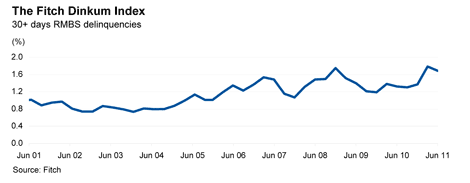Mortgage arrears high but stabilising: Fitch
The latest mortgage arrears report by Fitch suggests smaller lenders and non-banks are doing as good a job as the major banks in managing their mortgage risk.
The Fitch Dinkum 30+ Days RMBS Index (the Dinkum 30+) decreased to 1.69% in the second quarter of 2011 (from 1.79% in the first quarter).
Over the same period Moody’s calculated the national mortgage delinquency rate for 30 days plus rose from 1.36% to 1.67%, attributing this increase to weaknesses in the non-mining job sectors of the economy.
Residential mortgage-backed securities (RMBS) are a means for lenders to raise funds by selling bundles of loans to investors.
Major RMBS issuers include FirstMac, Challenger, Macquarie Bank’s PUMA fund, Resimac and Liberty Financial.
The percentage of borrowers more than 30 days behind on their mortgage repayments decreased in the second quarter of the year but remains at historically high levels, according to the latest Fitch Dinkum Index.
The index measures the performance of mortgages backed by residential mortgage backed securities (RMBS) – a means of funding loans outside of bank deposits.

The benchmark Fitch Dinkum 30+ Days RMBS Index (the Dinkum 30+) decreased to 1.69% in the second quarter of 2011 (from 1.79% in the first quarter).
The 0.1% decline was in line with forecasts, as the variables which negatively affected households during the first quarter of the year – increasing interest rates, natural disasters, seasonal spending – tailed off.
According to Fitch, 30+ days arrears have stabilised as a result of the RBA leaving the cash rate unchanged at 4.75% since November last year.
“The stable mortgage rates over the second quarter of 2011 have allowed households to slightly adjust to the challenges which hampered mortgage performance during the first quarter, such as increasing interest rates, natural disasters, and seasonal Christmas spending,” says James Zanesi, associate director in Fitch’s Structured Finance team.
“Mortgage performance is also expected to continue its stabilisation through the third quarter of 2011 as the effect of Christmas spending continues to pass through, borrowers affected by natural disasters in the first quarter continue to cure their delinquency status and households adjust their spending to the increases in mortgage rates over the last two years,” he adds.
The biggest threat to the performance of the mortgage market in the long term is the increasing cost of living, together with potentially higher levels of mortgage rates.
Fitch believes the current unemployment rate is not a concern for arrears in 2011.
Other key findings over the second quarter of 2011:
- Borrowers that take out low-doc loans, primarily those self-employed, employed) remain under pressure despite 30+ days delinquency rates decreased to 6.55% from 6.74% in the first quarter of the year.
- Arrears rates for non-conforming borrowers low-doc borrowers (loans for borrowers with poor credit history) decreased by 1.05% to 15.83%.
- The percentage of loans 30 to 59 days in arrears decreased by 8 basis points to 0.71%. Fitch expects this trend to continue, although eventual monetary policy decisions and the increased cost of living may potentially elevate mortgage arrears for longer.
The percentage of loans 60-89 in arrears decreased to by 3 basis points to 0.31%. As is the case for the Dinkum 30, the stabilisation of household expenditure has positively affected 60-89 days arrears. Fitch does not expect volatility in the 60-89 days delinquencies bucket in the long term.
- The percentage of loans more than 90 days in arrears increased marginally (1 basis point) to 0.66% but is still below the 0.72% peak reached in December 2008 (following the liquidity crunch). In the current scenario of relatively flat house prices, a strong economy and stable employment, it is very unlikely 90+ days delinquencies will reach a new peak.